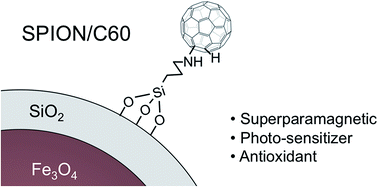Synthesis and characterization of multifunctional superparamagnetic iron oxide nanoparticles (SPION)/C60 nanocomposites assembled by fullerene–amine click chemistry†
Abstract
The fabrication of multifunctional nanostructures constitutes an interesting area of research. Here we used a simple fullerene–amine coupling chemistry to produce a photofunctional and antioxidant magnetic material composed of multiple C60 molecules covalently bound to core monodispersed superparamagnetic iron oxide nanoparticles (SPIONs). For this, core SPIONs were synthesized by thermal decomposition, using iron(III) acetylacetonate as the iron precursor, and the resulting hydrophobic SPIONs were coated with a thin amino-functionalized silica layer. C60 molecules were covalently linked to the core SPIONs by a simple fullerene–amine coupling reaction, a method promoting the assembly of the pursued nanocomposite. Fourier transform infrared spectroscopy, thermogravimetric analysis, and transmission electron microscopy were used all along the fabrication process to demonstrate the efficient assembly of the SPION/C60 nanocomposite. We confirm that the latter brings together the disparate physico-chemical properties of its components. Using vibrating sample magnetometry we demonstrate that the core SPION confers a superparamagnetic character to the nanocomposite. We also demonstrate that fullerenes confer photosensitizing properties to the latter, as illustrated by the photo-oxidation of 1,5-dihydroxynaphthalene. Interestingly, the hydrophobic SPION/C60 nanocomposite was easily solubilized in water using polyvinylpyrrolidone, offering the possibility of evaluating its properties in physiological conditions and paving the way to further biomedical applications. Therefore, we also demonstrate that water-soluble SPION/C60 has a good T2 relaxivity, conferred by its core superparamagnetic component, and could potentially be used as a contrast agent in magnetic resonance imaging. Furthermore, we show that the hydrophilic nanocomposite has a remarkable antioxidant capacity which is provided by its fullerene component. In summary, our work provides a facile method to produce composite nanostructures that bring together the attractive properties of monodispersed SPIONs and those of fullerene C60 molecules, which can be exploited in a broad range of applications, such as photodynamic therapy, photocatalytic oxidation of organic pollutants and radical scavenging, to name only a few.


 Please wait while we load your content...
Please wait while we load your content...